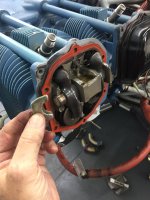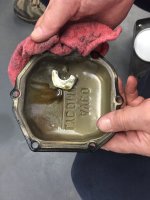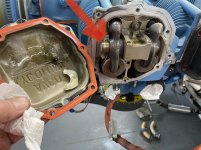I am experiencing symptoms consistent with a stuck exhaust valve, so I pulled the rocker cover and disassembled the exhaust valve for some borescope images. It shook so bad when it manifested in flight, I'm grounded until I figure out what this is. I did determine that the problem would slowly clear up at reduced throttle. It was only at WOT when the cylinder cut out.
When I pulled the valve stem out through the spark plug hole, it was very shiny and smooth. It also slid very easily in and out of the guide before I disassembled it. What is concerning to me, is the photos I have of the valve guide. It looks like a severe taper on the combustion side of the bore - I've never seen one before, so I'm not sure if this is normal.
I didn't do a wobble measurement, but I didn't feel anything excessive when I subjectively compared it to cylinder #2.
Superior XPIO-360, 1100hrs TT. Pmag/Lightspeed ignitions. 8.5:1 cylinders.
Is it time to pull the jug?
Don
When I pulled the valve stem out through the spark plug hole, it was very shiny and smooth. It also slid very easily in and out of the guide before I disassembled it. What is concerning to me, is the photos I have of the valve guide. It looks like a severe taper on the combustion side of the bore - I've never seen one before, so I'm not sure if this is normal.
I didn't do a wobble measurement, but I didn't feel anything excessive when I subjectively compared it to cylinder #2.
Superior XPIO-360, 1100hrs TT. Pmag/Lightspeed ignitions. 8.5:1 cylinders.
Is it time to pull the jug?
Don











